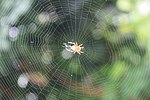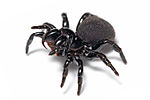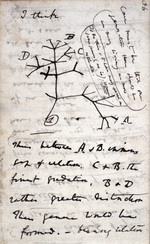araneoid spiders. Spider taxonomy Insect evolution Garwood, Russell J.; Dunlop, Jason (2014). "Three-dimensional reconstruction and the phylogeny of extinct...
13 KB (1,590 words) - 19:37, 10 August 2024
Orb-weaver spiders are members of the spider family Araneidae. They are the most common group of builders of spiral wheel-shaped webs often found in gardens...
43 KB (4,467 words) - 02:00, 15 August 2024
Sometimes one pair of eyes is better developed than the rest. Several families of hunting spiders, such as jumping spiders and wolf spiders, have fair to excellent...
12 KB (1,272 words) - 01:12, 20 September 2024
architectures; other names for this spider family include tangle-web spiders and comb-footed spiders.[citation needed] When spiders moved from the water to the...
37 KB (4,388 words) - 18:36, 13 August 2024
of the earliest forms, and spiders that produce tangled cobwebs are more abundant and diverse than orb-weaver spiders. Spider-like arachnids with silk-producing...
121 KB (13,435 words) - 15:46, 13 September 2024
scientific names of some 67 spiders species in his Svenska Spindlar ("Swedish Spiders"), one year before Linnaeus named over 30 spiders in his Systema Naturae...
34 KB (2,202 words) - 00:02, 17 September 2024
Arachnophobia (redirect from Fear of spiders)
is that the presence of venomous spiders led to the evolution of a fear of spiders, or made the acquisition of a fear of spiders especially easy. However...
17 KB (1,579 words) - 20:12, 8 September 2024
Mygalomorphae (section Evolution)
as trapdoor spiders due to their creation of trapdoors over their burrows. Other prominent groups include Australian funnel web spiders and tarantulas...
28 KB (1,787 words) - 09:56, 26 March 2024
production of new spider webs. Some spiders, such as the dewdrop spiders (Argyrodes), even eat the silk of other spider species. Spiders typically have...
21 KB (2,531 words) - 06:50, 19 August 2024
Chelicerata (redirect from Reproductive systems of chelicerates)
(kéras) 'horn') constitutes one of the major subdivisions of the phylum Arthropoda. Chelicerates include the sea spiders, horseshoe crabs, and arachnids...
84 KB (8,304 words) - 02:07, 31 August 2024
Deinopidae (redirect from Net-casting spider)
casting spiders, is a family of cribellate spiders first described by Carl Ludwig Koch in 1850. It consists of stick-like elongated spiders that catch...
4 KB (412 words) - 14:23, 26 August 2024
Jumping spiders are a group of spiders that constitute the family Salticidae. As of 2019, this family contained over 600 described genera and over 6,000...
45 KB (4,823 words) - 21:13, 13 September 2024
spiders" are not true spiders, nor even arachnids, their traditional classification as chelicerates would place them closer to true spiders than to other well-known...
29 KB (3,092 words) - 16:02, 11 August 2024
into book lungs in primitive spiders and finally into tracheae in more advanced spiders (most of them still have a pair of book lungs intact as well),...
99 KB (12,169 words) - 02:15, 5 July 2024
passing prey in or near the mouth of a burrow. Wolf spiders resemble nursery web spiders (family Pisauridae), but wolf spiders carry their egg sacs by attaching...
26 KB (2,678 words) - 04:54, 12 September 2024
Arthropod (redirect from Evolution of arthropods)
comprise the marine sea spiders and horseshoe crabs, along with the terrestrial arachnids such as mites, harvestmen, spiders, scorpions and related organisms...
131 KB (12,443 words) - 01:08, 19 September 2024
Lampshade spiders, family Hypochilidae, are among the most primitive of araneomorph spiders. There are two genera and twelve species currently recognized...
7 KB (563 words) - 16:29, 15 October 2023
A number of spiders can cause spider bites that are medically important. Almost all spiders produce venom but only a few are classified as "venomous" and...
40 KB (4,803 words) - 00:27, 2 July 2024
Cribellum (category Spider anatomy)
certain groups of spider species, so-called cribellate spiders, the cribellum is a silk spinning organ. Unlike the usual spinnerets of spiders, the cribellum...
8 KB (931 words) - 21:26, 16 September 2024
Thomisidae (redirect from Crab spiders)
families of spiders. Many members of this family are also known as flower spiders or flower crab spiders. Members of this family of spiders do not spin...
20 KB (1,699 words) - 16:59, 15 September 2024
(/əˈræknɪdə/) of the subphylum Chelicerata. Arachnida includes, among others, spiders, scorpions, ticks, mites, pseudoscorpions, harvestmen, camel spiders, whip...
56 KB (4,754 words) - 21:10, 16 September 2024
Evolution is the change in the heritable characteristics of biological populations over successive generations. It occurs when evolutionary processes...
238 KB (24,717 words) - 15:06, 14 September 2024
Argiope bruennichi (redirect from Wasp spider)
reproducing with the same female. Because of the damage caused to the male spiders when this act takes place, these spiders are usually monogamous. If the females...
10 KB (1,014 words) - 16:15, 30 August 2024
diversification of molluscs through geologic time Evolution of spiders – Origin from a chelicerate ancestor and diversification of spiders through geologic...
26 KB (4,576 words) - 07:42, 12 August 2024
Trichonephila (category Spider stubs)
introduced to the genus that has considerably shrunk the size of the spiders, are pesticides, as spiders have been reported smaller in size when living in areas...
12 KB (1,227 words) - 19:24, 31 August 2024
Velvet spiders (family Eresidae) are a small group (about 100 species in 9 genera) of spiders almost entirely limited to the Old World, with the exception...
6 KB (539 words) - 22:12, 3 August 2024
Spitting spiders (Scytodidae) is a family of araneomorph spiders first described by John Blackwall in 1864. It contains over 250 species in five genera, of which...
5 KB (465 words) - 22:22, 17 September 2024
is a family of mygalomorph spiders, commonly known as Australian funnel-web spiders or atracids. It has been included as a subfamily of the Hexathelidae...
27 KB (2,962 words) - 19:00, 14 May 2024
Solifugae (redirect from Camel Spiders)
Solifugae is an order of arachnids known variously as solifuges, sun spiders, camel spiders, and wind scorpions. The order includes more than 1,000 described...
33 KB (3,456 words) - 14:25, 11 September 2024
however, appear to be crucial for the evolution of sociality in spiders. Recent theory suggests that social spiders evolved along a restricted pathway through...
15 KB (1,742 words) - 10:09, 21 June 2024




























